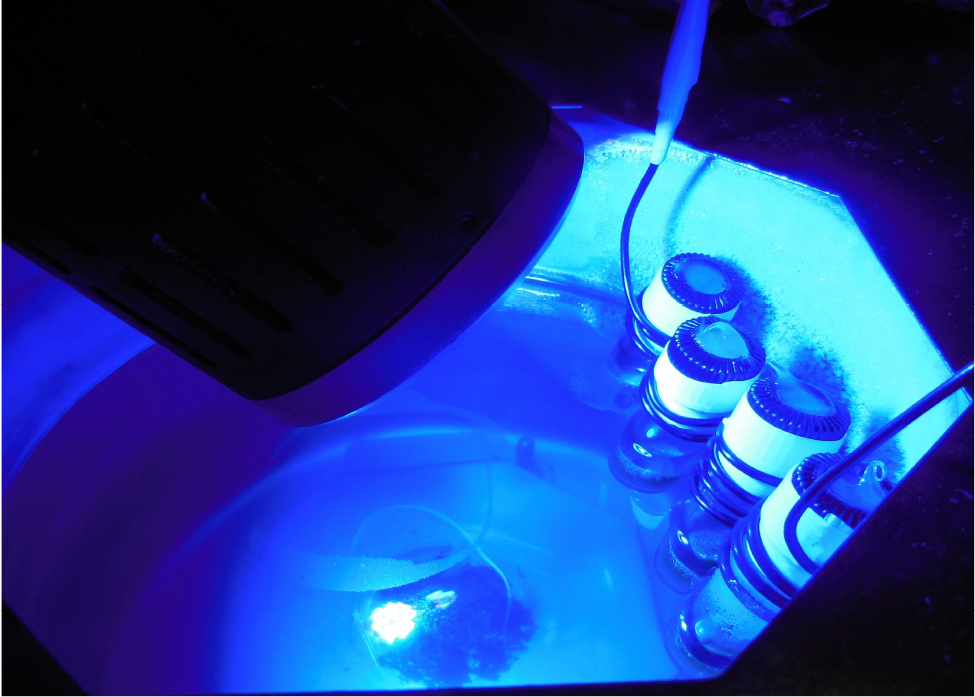The need for precious metals has been eliminated by the advancement of a new method that has helped create a highly useful chemical subunit. This possibly results in the sustainable production of electronics and pharmaceuticals.
 Reaction vials being exposed to blue light from an LED. Image Credit: Yusuke Masuda.
Reaction vials being exposed to blue light from an LED. Image Credit: Yusuke Masuda.
Generally, light-emitting diodes (LEDs) find their applications in electronic displays in smartphones, TVs and other devices. Recently, scientists from the Institute of Chemical Reaction Design and Discovery (ICReDD) at Hokkaido University have used blue LEDs to design a more sustainable approach to make main chemical subunits that can be used in the development of photoelectronic and pharmaceutical industries.
Blue LEDs have been utilized by the researchers jointly with a copper-based molecular catalyst to perform what is called a cross-coupling reaction. Here, two molecules are combined through a carbon-carbon bond.
This is one of the most extensively utilized reactions and is essential for making the majority of the chemical products currently in use. The use of copper — an affordable and more commonly available metal — as a catalyst for a cross-coupling reaction is considered to be a significant discovery in sustainability, as this reaction normally depends on the use of precious metals like palladium.
Furthermore, the new method is useful since the copper metal in the molecular catalyst itself absorbs the blue light, instead of requiring an individual light-absorbing compound besides the catalyst. This makes the synthesis not only affordable and easy to perform but also simpler to control, as there are lesser moving parts.
Blue light plays the main role in triggering the copper-based catalyst. Theoretical calculations showed that this light exposure makes electrons shift from the metal copper atom to a linked subunit of the molecular catalyst.
This excited state has isolated electrical charges, thereby making the catalyst highly reactive, and scientists were able to utilize it to perform a cross-coupling reaction that makes an acyl group. This is beneficial for the synthesis of photoelectronic and pharmaceuticals materials.
The main feature of this technique is that the formation of the acyl group takes place asymmetrically. This implies that one of the two possible mirror-image versions of the product molecule is produced selectively, a feature highly preferred for the development of new medicines.
The new method was tested by the researchers with several different starting materials, especially containing a material derived from probenecid, a medicine used for gout treatment. The product they achieved from this starting material has possible applications in the pharmaceutical industry. The high selectivity of this technique and its compatibility with compounds utilized in medicine underlines its potential utility.
Implementation of this new technique has been anticipated to both offer cost savings and raise the sustainability of the production of an extensive range of chemical compounds with hopeful uses in electronics and medicine. Its usage of commonly available materials makes it notably attractive.
This synthetic method is a breakthrough because it combines two easily obtainable items, blue LED light, and copper, to achieve a coupling reaction that did not exist before. Technology that produces useful compounds from resources which are abundantly available on Earth is critical for the sustainable development of humanity. I expect this advance will become a milestone in the development of sustainable molecular synthetic methods.
Yusuke Masuda, Assistant Professor, Hokkaido University
This work was financially supported by JSPS KAKENHI Grants JP21H04680, JP18H03906 in Grant-in-Aid for Scientific Research (A), Grant JP21J11643 in Grant-in-Aid for JSPS Fellows, Grant JP21K14626 in Grant-in-Aid for Early-Career Scientists, Grant JP20H04793 in Grant-in-Aid for Scientific Research on Innovative Areas, “Hybrid Catalysis”, and Grant JP19H02737 in Grant-in-Aid for Scientific Research (B).
Journal Reference:
Ueda, Y., et al. (2022) Photoinduced Copper-Catalyzed Asymmetric Acylation of Allylic Phosphates with Acylsilanes. Journal of American Chemical Society. https://doi.org/10.1021/jacs.1c11526.